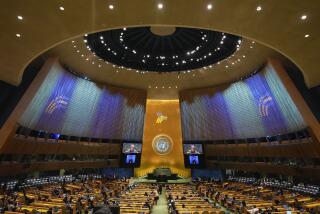The Summit’s Goals
- Share via
Delegates from more than 190 nations signed on to a blueprint to aid the poor and protect Earth’s environment. The 65-page Johannesburg Implementation Plan sets forth an ambitious agenda. But the plan is nonbinding, raising questions as to how, or if, these goals will be met. Here are some prominent ones:
Clean water
Reduce by half the 1.1 billion people who lack clean drinking water and basic sanitation by 2015. The promise is welcomed by development charities as an important step toward preventing the 2 million deaths a year, mostly among children, from water-borne illnesses such as cholera.
*
Health
Ensure that drug-company patents do not prevent poor countries from making medicines available to poor people; make antiviral drugs available to all infected by HIV/AIDS; reduce incidence of HIV among teenagers and young adults, ages 15 to 24, by 25% in the most affected countries by 2005 and globally by 2010.
*
Toxic chemicals
Phase out lead-based paints worldwide as well as lead in gasoline; make sure all chemicals are produced and used in ways that do not harm human health or the environment by 2020.
*
Oceans
Cease destructive fishing practices and establish a network of marine protected areas that are off limits to fishing by 2012; eliminate subsidies that contribute to excessive and illegal fishing.
*
Global warming
Reaffirms commitment to stabilize greenhouse gas emissions from fossil fuels; governments that have ratified the Kyoto Protocol, which sets up targets to reduce globe-warming gases, encourage others to ratify the treaty.
*
Poverty
Reduce by half the proportion of people who live in poverty--defined as those whose income is less than $1 a day--and suffer from hunger; make elementary schooling available to all children by 2015; significantly improve the lives of at least 100 million slum dwellers by 2020 and establish a fund to wipe out poverty.
*
Biodiversity
Cut significantly the rate at which rare animals and plants are becoming extinct by controlling invasive species and protecting important habitat for species in forests, wetlands and coral reefs.
Source: United Nations
More to Read
Sign up for Essential California
The most important California stories and recommendations in your inbox every morning.
You may occasionally receive promotional content from the Los Angeles Times.













